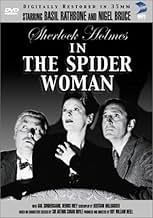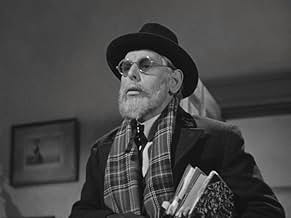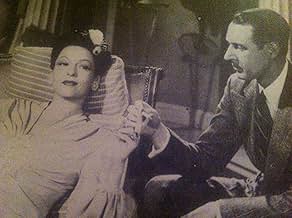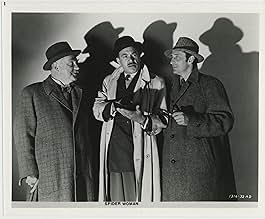IMDb-BEWERTUNG
7,0/10
5477
IHRE BEWERTUNG
Sherlock Holmes untersucht eine Serie von sogenannten "Pyjama-Selbstmorden". Er weiß, dass der weibliche Bösewicht dahinter so gerissen wie Moriarty und so giftig wie eine Spinne ist.Sherlock Holmes untersucht eine Serie von sogenannten "Pyjama-Selbstmorden". Er weiß, dass der weibliche Bösewicht dahinter so gerissen wie Moriarty und so giftig wie eine Spinne ist.Sherlock Holmes untersucht eine Serie von sogenannten "Pyjama-Selbstmorden". Er weiß, dass der weibliche Bösewicht dahinter so gerissen wie Moriarty und so giftig wie eine Spinne ist.
- Regie
- Drehbuch
- Hauptbesetzung
Jimmy Aubrey
- News Vendor
- (Nicht genannt)
Mary Bayless
- Carnival Patron
- (Nicht genannt)
Brandon Beach
- Carnival Patron
- (Nicht genannt)
Frank Benson
- Toy Doll Attendant
- (Nicht genannt)
Lydia Bilbrook
- Susan
- (Nicht genannt)
John Burton
- Radio Announcer
- (Nicht genannt)
James Carlisle
- Casino Patron
- (Nicht genannt)
Harry Cording
- Fred Garvin
- (Nicht genannt)
Jack Deery
- Casino Patron
- (Nicht genannt)
Herschel Graham
- Casino Patron
- (Nicht genannt)
Empfohlene Bewertungen
The fifth installment in Universal's Sherlock Holmes series and one of the best. "Spider Woman" finds Basil Rathbone matching wits with the enticing title character, superbly played by the beautiful Gale Sondergaard. Rathbone's Holmes is brilliant as always, but even Nigel Bruce's Dr. Watson is permitted to show some brains for once in this immensely entertaining mystery. A good show all around, although this series would really hit its peak with the next episode, "The Scarlet Claw."
In wartime Britain, a series of well-known men commit suicide - their only connection being the fact that they are all gamblers. This happens while Holmes and Watson are holidaying in Scotland when this is happening and Holmes fakes his own death to be able to go back to London in disguise and work on the case. He finds the killer with ease but not the method or motive for the murders.
The interesting set up of graphic suicides (or at least graphic for the time) had me from the start but the film didn't manage to hold me throughout the running time although it got better towards the end. The usual `he's dead - oh, he's not' thing didn't really work for me but happily the film didn't labour this ruse too long. The plot does have certainly `different' aspects to it, they may not be supernatural as such but they are certainly different from the usual fare. There isn't anything too wrong about this but I didn't totally get won over by it.
The film does have some fine moments to it - the scene where Watson unwittingly is made to try and kill Holmes, very tense and enjoyable and ends with a Holmes line that Bond himself would have been proud of: `I was just going round and round but my heart wasn't really in it'! The confrontations between Holmes and Spedding are enjoyable - she is an extraordinary villain and she matches Holmes well.
Rathbone does good work and he does bring out a reasonable chemistry with Sondergaard that helps the fact that they are meant to be against each other. Bruce is good and seems to be growing in confidence (or at least what the film allows him to do) with some good quips of his own. Hoey is always a welcome addition to the cast and he is a good comic relief that takes the pressure off Bruce somewhat.
Overall, the plot didn't totally hang together for me and it lacked a little bit of logic as a result of the slightly unusal nature of the murders and the criminals involved but it is still very enjoyable and the conclusion in the fairground is a lot tenser than a B-movie deserves to be!
The interesting set up of graphic suicides (or at least graphic for the time) had me from the start but the film didn't manage to hold me throughout the running time although it got better towards the end. The usual `he's dead - oh, he's not' thing didn't really work for me but happily the film didn't labour this ruse too long. The plot does have certainly `different' aspects to it, they may not be supernatural as such but they are certainly different from the usual fare. There isn't anything too wrong about this but I didn't totally get won over by it.
The film does have some fine moments to it - the scene where Watson unwittingly is made to try and kill Holmes, very tense and enjoyable and ends with a Holmes line that Bond himself would have been proud of: `I was just going round and round but my heart wasn't really in it'! The confrontations between Holmes and Spedding are enjoyable - she is an extraordinary villain and she matches Holmes well.
Rathbone does good work and he does bring out a reasonable chemistry with Sondergaard that helps the fact that they are meant to be against each other. Bruce is good and seems to be growing in confidence (or at least what the film allows him to do) with some good quips of his own. Hoey is always a welcome addition to the cast and he is a good comic relief that takes the pressure off Bruce somewhat.
Overall, the plot didn't totally hang together for me and it lacked a little bit of logic as a result of the slightly unusal nature of the murders and the criminals involved but it is still very enjoyable and the conclusion in the fairground is a lot tenser than a B-movie deserves to be!
One of the best in Universal's Sherlock Holmes series, The Spider Woman dispenses, for the most part, with the overt WWII subject matter (which was also reasonably sparse in the previous outing, Sherlock Holmes Faces Death). The climax does make use of the image of Hitler and other Axis figures, but this was (aside from a brief mention in Dressed to Kill) the final direct war reference in the series. This bears mentioning because the film benefits strongly from the general lack of wartime subterfuge. Rather than battling Nazi agents, Rathbone's Sherlock is embroiled in a truly Holmesian mystery, surrounding several apparent suicides...which Holmes, naturally (and correctly), deduces to be homicides.
Though the opening credits proclaim "Based on a Story by Arthur Conan Doyle," The Spider Woman adapts (quite freely) major incidents from no less than five of Conan Doyle's tales...The Sign of Four, The Speckled Band, The Final Problem, The Empty House (also referenced in Sherlock Holmes and the Secret Weapon), and The Devil's Foot. False advertising, maybe...but the script (courtesy of Bertram Millhauser) manages to weave them all into a framework that makes for a fun and intriguing mystery.
Other assets include the performances, which are better than in some of the earlier films (though Rathbone and Bruce never disappointed), and the more sure-handed guidance of regular directer Roy William Neill...by this time, a vast improvement over the direction in his first Holmes outing, Sherlock Holmes and the Secret Weapon. It's also appropriate (if somewhat superficial) to note that Holmes's hairstyle, which changed for the better in Sherlock Holmes Faces Death, thankfully does not revert in this one (nor at any time for the duration of the series) to the shambles that it was in the first three films.
All in all, one of the best made, and most entertaining, films in the Universal series. It doesn't quite rise to the heights of The Scarlet Claw, but it's easily one of the best.
Though the opening credits proclaim "Based on a Story by Arthur Conan Doyle," The Spider Woman adapts (quite freely) major incidents from no less than five of Conan Doyle's tales...The Sign of Four, The Speckled Band, The Final Problem, The Empty House (also referenced in Sherlock Holmes and the Secret Weapon), and The Devil's Foot. False advertising, maybe...but the script (courtesy of Bertram Millhauser) manages to weave them all into a framework that makes for a fun and intriguing mystery.
Other assets include the performances, which are better than in some of the earlier films (though Rathbone and Bruce never disappointed), and the more sure-handed guidance of regular directer Roy William Neill...by this time, a vast improvement over the direction in his first Holmes outing, Sherlock Holmes and the Secret Weapon. It's also appropriate (if somewhat superficial) to note that Holmes's hairstyle, which changed for the better in Sherlock Holmes Faces Death, thankfully does not revert in this one (nor at any time for the duration of the series) to the shambles that it was in the first three films.
All in all, one of the best made, and most entertaining, films in the Universal series. It doesn't quite rise to the heights of The Scarlet Claw, but it's easily one of the best.
The 1942-43 Holmes/Watson films are often pathetic nonsense involving Nazi spies and have Holmes dashing all over the place firing guns at all and sundry, which doesn't work at all.
Yes, this is wartime, and the targets in the fairground shooting gallery are Hitler, Hirohito and Mussolini, but this is a proper detective story about mysterious murders.
It's an amalgam of Conan Doyle's original stories The Sign of Four and The Final Problem rather than a farrago of cod secret agents, and it works pretty well as a mystery.
Gale Sondergaard makes a marvellous villain, and plays excellently opposite Rathbone's Holmes.
Well worth while
Yes, this is wartime, and the targets in the fairground shooting gallery are Hitler, Hirohito and Mussolini, but this is a proper detective story about mysterious murders.
It's an amalgam of Conan Doyle's original stories The Sign of Four and The Final Problem rather than a farrago of cod secret agents, and it works pretty well as a mystery.
Gale Sondergaard makes a marvellous villain, and plays excellently opposite Rathbone's Holmes.
Well worth while
The "hopping boy" with cat-quick reflexes is one of the most unusual and unsettling figures of the decade. I don't think I've ever seen such an imaginative and offbeat use of a young person in any other movie. The film itself has many imaginative touches, but among them, it's that bizarre little "hop" (never explained, and neither is the boy) that's so memorable. He's a perfect adjunct to the leeringly evil Adrea (Sondergaard) who looks like she's having a delicious time playing cat-and-mouse with the tricky Sherlock (Rathbone). In fact, their devious encounters are models of beautifully "layered" acting as each has several things going on internally at the same time. She's a perfect foil for the master detective, with a flashy smile that says one thing while her eyes say another. Too bad the imperious Sondergaard was lost to the blacklist of the early 50's.
I never did figure out just how the pygmy (Angelo Rossito in blackface) fit into the suicide scheme, but that's okay because the movie has so many intriguing touches, including the highly contrived but suspenseful climax. Even Hoey's Inspector Lestrade is wisely restrained, and when he walks off proudly arm-in-arm with the eye-catching Adrea at the end, it's a rather charming little moment. I guess my only complaint is with the poorly done process shot of the raging river that contrasts starkly with the well-stocked foreground. Nonetheless, this is one of the most imaginative entries of any detective series of the period.
I never did figure out just how the pygmy (Angelo Rossito in blackface) fit into the suicide scheme, but that's okay because the movie has so many intriguing touches, including the highly contrived but suspenseful climax. Even Hoey's Inspector Lestrade is wisely restrained, and when he walks off proudly arm-in-arm with the eye-catching Adrea at the end, it's a rather charming little moment. I guess my only complaint is with the poorly done process shot of the raging river that contrasts starkly with the well-stocked foreground. Nonetheless, this is one of the most imaginative entries of any detective series of the period.
Wusstest du schon
- WissenswertesAt one point Holmes says to Watson, "If you ever see me getting too sure again, fancying myself more clever than Adrea Spedding, just whisper one word to me: pygmy." This line was inspired by the short story "The Adventure of the Yellow Face," in which Holmes tells Watson, "If it should ever strike you that I am getting a little over-confident in my powers, or giving less pains to a case than it deserves, kindly whisper 'Norbury' in my ear, and I shall be infinitely obliged to you."
- PatzerHomes 'corrects' the fake Matthew Ordway by saying that Ordway should have said that 'the virus [of the spiders] was valuable to toxicologists.' He should have said venom, not virus.
- Zitate
Artie - Shooting Gallery Attendant: Hey gov', sir, try your luck on Mussolini, Hiro Hito, or Hitler. Hit 'em where their hearts ought to be and listen to the 'ollow sound.
- VerbindungenEdited into Who Dunit Theater: Sherlock Holmes and the Spider Woman (2021)
- SoundtracksLoch Lomond
(uncredited)
Traditional
Heard as a theme
Top-Auswahl
Melde dich zum Bewerten an und greife auf die Watchlist für personalisierte Empfehlungen zu.
- How long is The Spider Woman?Powered by Alexa
Details
- Erscheinungsdatum
- Herkunftsland
- Sprache
- Auch bekannt als
- The Spider Woman
- Drehorte
- Produktionsfirma
- Weitere beteiligte Unternehmen bei IMDbPro anzeigen
- Laufzeit1 Stunde 3 Minuten
- Farbe
- Seitenverhältnis
- 1.37 : 1
Zu dieser Seite beitragen
Bearbeitung vorschlagen oder fehlenden Inhalt hinzufügen

Oberste Lücke
By what name was Das Spinnennest (1943) officially released in Canada in English?
Antwort






























